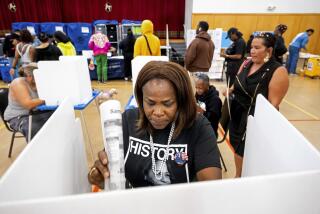Lessons on the Mechanics of Democracy : *Elections: If we changed the winner-take-all system, we’d have higher voter turnout and more representative governing.
- Share via
Imagine your car breaking down on the highway, totally dead. It won’t restart, so you have it towed to a mechanic who looks it over and promptly announces, “You have to fix the headlights.”
You don’t have to be a mechanical genius to know that the problem is not the headlights. The problem, most certainly, has to do with the engine.
The final recommendations of the California Constitution Revision Commission are a lot like that myopic mechanic. That commission was charged with the task of divining ways of “improving accountability and responsiveness of government,” “making government more representative” and other worthy goals.
Among the commission’s recommendations were: making the offices of the state treasurer, schools superintendent and insurance commissioner appointive rather than elective; tightening the state initiative process; and requiring that two-year state budgets be approved by a simple majority of the Legislature rather than the current two-thirds.
While some of these recommendations are definitely an improvement, one wants to yell as loudly as possible: “It’s the engine, stupid!”
The engine of any democracy is the voting system. In America we use an antiquated 200-year-old “winner-take-all” system that most of the major democracies of the world long ago discarded in favor of proportional representation. Here are a few comparisons:
% The U.S. is near the bottom in terms of voter turnout. For the 1994 congressional elections, eligible voter turnout was an embarrassingly low 36%; California voter turnout was 33%. Such low participation is typical for winner-take-all countries. Meanwhile, proportional representation democracies enjoy turnouts of 70% to more than 90%.
% Of the 33% of Californians who bothered voting, only 62% voted for a winner. That means only 21% of eligible voters elected someone. The figure was about the same for the U.S. as a whole, where fewer than 45 million voters chose the representation for more than 193 million eligible voters. Meanwhile, in the 1994 proportional representation elections in Germany and South Africa, 76.3% and 85%, respectively, of eligible voters helped elect someone.
% 71% of Californians lived in congressional districts that were won by a landslide (defined as winning by 20% or more). Most voters do not live in competitive districts where their votes could make a difference.
The picture that emerges about democracy in California and the U.S. is that most people don’t vote, and of those few who do vote, their vote doesn’t count for much.
This leads one to conclude that voters are no longer buying what the two major parties are selling. Voters want more electable choices--including third parties and independents--that are not trying to con them for their votes and that stand on principles they can be held accountable for.
A winner-take-all system will never deliver that. It’s not a matter of appointing state officers or changing the initiative process or approving budgets by a majority. It’s the engine of this democracy that is broken, not the headlights. The more modern proportional representation voting systems can deliver what voters are yearning for and what the Constitution Revision Commission was charged with delivering: more representation, more accountability, more responsiveness.
The panel heard testimony about proportional representation from many people around the state. But they didn’t study the idea seriously enough. Their final recommendations will do little to jump start the dead automobile of our democracy.
More to Read
Get the L.A. Times Politics newsletter
Deeply reported insights into legislation, politics and policy from Sacramento, Washington and beyond. In your inbox twice per week.
You may occasionally receive promotional content from the Los Angeles Times.








